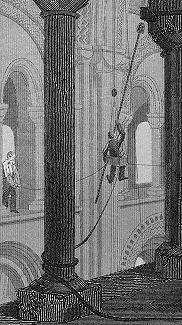Pictures in Print
Conservation
 The main conservation element of the project has been providing decent storage for the material, just as much of the obvious minor damage suffered by the documents was a result of there having been too loosely stored in the past.
The main conservation element of the project has been providing decent storage for the material, just as much of the obvious minor damage suffered by the documents was a result of there having been too loosely stored in the past.
The most common task was the repairing of minor tears to the edges. Fortunately most items have large borders around the printed area, which has absorbed most of the damage, but these tears tend to spread over the face of the print very easily, so preventative work can save a great deal of more painstaking repair at a later date.
Prints and maps are sometimes treated as decorative pieces, which means they are subjected to a wide variety of display methods. Properly framed they seem to come to little harm (providing they are not hung in direct sunlight, damp or other bad conditions), but other mounting techniques have proven more problematic. Mounting on highly acidic cardboard and liberal coats of varnish are two of the less reversible problems, but where possible prints have been dismounted from the many types of backing to which they have been stuck.
A noticable feature, especially amongst the 19th century prints, is foxing, which shows up in many of the scanned images.
Albums and grangerised volumes
The project provided a good snapshot of the various methods collectors used to assemble loose items, especially in the 19th century. These range from the almost ephemeral bundling up of sheets with tape or in paper folders to elaborate multi-volume bound sets. While it is desirable to preserve these intact as evidence of how material was collected, it does not always serve the best interests of the prints. Scrap book paper is often of poor quality and acidic: this not only threatens the item mounted on the paper, but when the paper crumbles the pages become detached. If the album reaches this stage then intervention is required. In most cases, before this stage has been reached, the spine will have disintegrated. Albums were not designed for long term survival, and sticking items onto each page will increase the thickness of the book threefold. While some volumes are designed to cope with this, in most cases this will place a destructive strain on the spine, which will have been already weakened by use. Albums tend to be flipped through back and forth, rather than placed under the more equal strain of a (perhaps idealised) reading from cover to cover.
Elaborate examples of rebound county histories were also found. In one case the original was not only interleaved with blank sheets for additional pictures but each page of the original was mounted in the centre of a blank sheet of paper so that the result was nine times the size of the source. These large volumes measure 56 x 67 cm and are part of a twelve volume set covering Newcastle and the counties of Northumberland and Durham. While they were designed to withstand more than an album, these volumes too suffer from loss of spines and detached pages.
Both albums and grangerised volumes present special problems in collections. If a print is requested, the entire volume has to be produced (in the case of the larger volumes this may require two people ), and exhibiting any print means filling an entire display case with the one opened volume. In many ways it would be easier to deal with this form of material by taking down the binding and storing as loose sheets in portfolios, but preservation of the integrity of the object was observed.
Framed items
A similar problem was encountered with framed and mounted items. In some cases, the frame or mount was the only thing holding the item together but heavy handed mounting in the past was sometimes a source of irreparable damage. The same question of preservation of the integrity of the object arose, although framing methods varied in quality (and possibly age). In general, framed objects were left in situ if the frame was not likely to cause harm, but (where possible) objects mounted on poor quality card were removed if this was not too complex or risky a task. Linen mounted dissected maps generally survived well, although heavy use and folding lead to fraying of the linen thread, or more problematically, disintegration of the edges of the document. While loosely rolled maps generally survived well, in some cases where they had been backed with linen, varnished and rolled with wooden poles at either end, crumbling was a serious problem with pieces of the map disintegrating.
Back to table of contents
Page maintained by Richard Higgins
(e mail - r.i.higgins@durham.ac.uk). Last revised: May 2004
 The main conservation element of the project has been providing decent storage for the material, just as much of the obvious minor damage suffered by the documents was a result of there having been too loosely stored in the past.
The main conservation element of the project has been providing decent storage for the material, just as much of the obvious minor damage suffered by the documents was a result of there having been too loosely stored in the past.